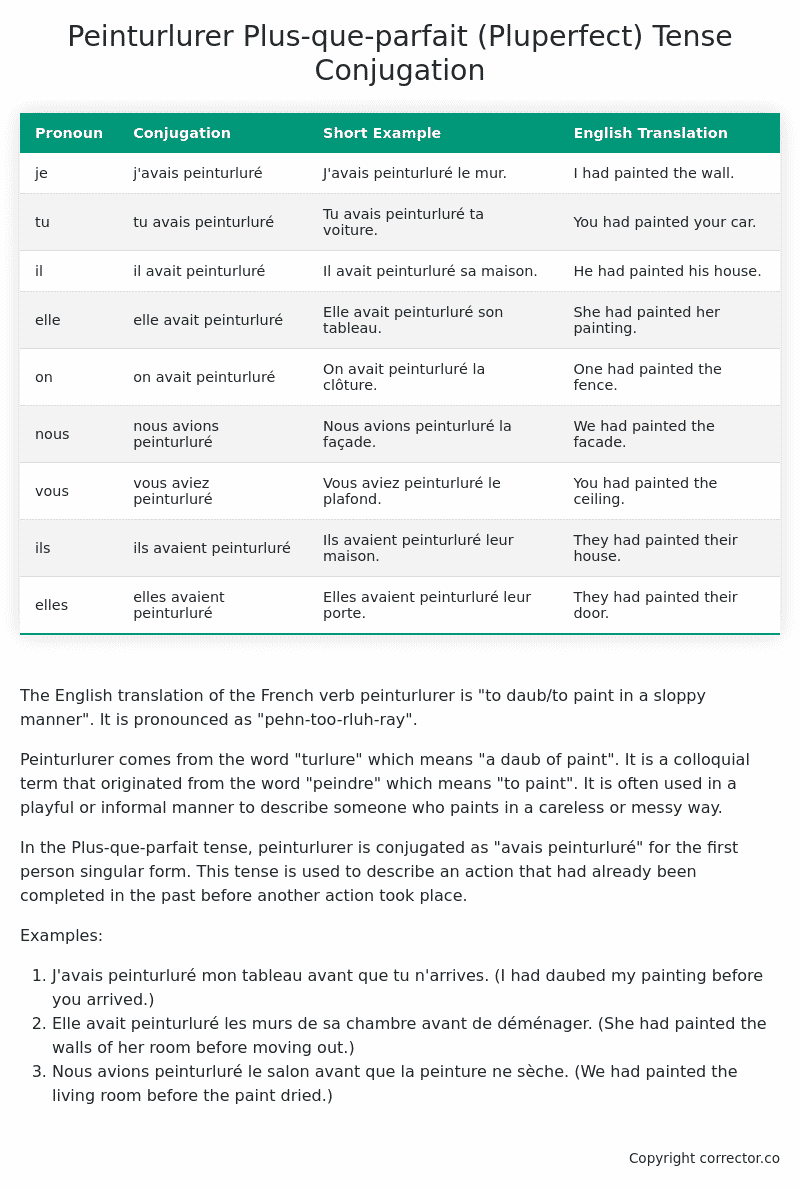Plus-que-parfait (Pluperfect) Tense Conjugation of the French Verb peinturlurer
Introduction to the verb peinturlurer
The English translation of the French verb peinturlurer is “to daub/to paint in a sloppy manner”. It is pronounced as “pehn-too-rluh-ray”.
Peinturlurer comes from the word “turlure” which means “a daub of paint”. It is a colloquial term that originated from the word “peindre” which means “to paint”. It is often used in a playful or informal manner to describe someone who paints in a careless or messy way.
In the Plus-que-parfait tense, peinturlurer is conjugated as “avais peinturluré” for the first person singular form. This tense is used to describe an action that had already been completed in the past before another action took place.
Examples:
- J’avais peinturluré mon tableau avant que tu n’arrives. (I had daubed my painting before you arrived.)
- Elle avait peinturluré les murs de sa chambre avant de déménager. (She had painted the walls of her room before moving out.)
- Nous avions peinturluré le salon avant que la peinture ne sèche. (We had painted the living room before the paint dried.)
Table of the Plus-que-parfait (Pluperfect) Tense Conjugation of peinturlurer
| Pronoun | Conjugation | Short Example | English Translation |
|---|---|---|---|
| je | j’avais peinturluré | J’avais peinturluré le mur. | I had painted the wall. |
| tu | tu avais peinturluré | Tu avais peinturluré ta voiture. | You had painted your car. |
| il | il avait peinturluré | Il avait peinturluré sa maison. | He had painted his house. |
| elle | elle avait peinturluré | Elle avait peinturluré son tableau. | She had painted her painting. |
| on | on avait peinturluré | On avait peinturluré la clôture. | One had painted the fence. |
| nous | nous avions peinturluré | Nous avions peinturluré la façade. | We had painted the facade. |
| vous | vous aviez peinturluré | Vous aviez peinturluré le plafond. | You had painted the ceiling. |
| ils | ils avaient peinturluré | Ils avaient peinturluré leur maison. | They had painted their house. |
| elles | elles avaient peinturluré | Elles avaient peinturluré leur porte. | They had painted their door. |
Other Conjugations for Peinturlurer.
Le Present (Present Tense) Conjugation of the French Verb peinturlurer
Imparfait (Imperfect) Tense Conjugation of the French Verb peinturlurer
Passé Simple (Simple Past) Tense Conjugation of the French Verb peinturlurer
Passé Composé (Present Perfect) Tense Conjugation of the French Verb peinturlurer
Futur Simple (Simple Future) Tense Conjugation of the French Verb peinturlurer
Futur Proche (Near Future) Tense Conjugation of the French Verb peinturlurer
Plus-que-parfait (Pluperfect) Tense Conjugation of the French Verb peinturlurer (this article)
Passé Antérieur (Past Anterior) Tense Conjugation of the French Verb peinturlurer
Futur Antérieur (Future Anterior) Tense Conjugation of the French Verb peinturlurer
Subjonctif Présent (Subjunctive Present) Tense Conjugation of the French Verb peinturlurer
Subjonctif Passé (Subjunctive Past) Tense Conjugation of the French Verb peinturlurer
Subjonctif Imparfait (Subjunctive Imperfect) Tense Conjugation of the French Verb peinturlurer
Conditionnel Présent (Conditional Present) Tense Conjugation of the French Verb peinturlurer
Conditionnel Passé (Conditional Past) Tense Conjugation of the French Verb peinturlurer
L’impératif Présent (Imperative Present) Tense Conjugation of the French Verb peinturlurer
L’infinitif Présent (Infinitive Present) Tense Conjugation of the French Verb peinturlurer
Struggling with French verbs or the language in general? Why not use our free French Grammar Checker – no registration required!
Get a FREE Download Study Sheet of this Conjugation 🔥
Simply right click the image below, click “save image” and get your free reference for the peinturlurer Plus-que-parfait tense conjugation!

Peinturlurer – About the French Plus-que-parfait (Pluperfect) Tense
Tense Formation
Common everyday usage patterns
Sequencing of past events
Background information
Hypothetical or reported speech
Interactions with other tenses
Summary
I hope you enjoyed this article on the verb peinturlurer. Still in a learning mood? Check out another TOTALLY random French verb conjugation!


